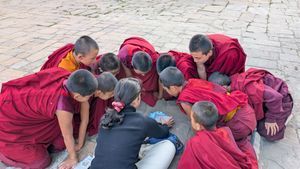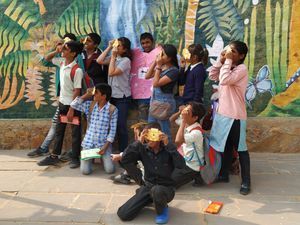The Story of Mosquito Larva and The Colony of Vorticella
 Sep 18, 2019 • 9:58 AM UTC
Sep 18, 2019 • 9:58 AM UTC Unknown Location
Unknown Location 140x Magnification
140x Magnification Unknown
Unknown
akshathanayak
Between the mountains and the oceans, you're bound to find me!
4posts
2comments
3locations

Just around
the monsoon times when the rain patterns get irregular, there lie a number of
tiny pools and puddles of stagnant water with mosquitos breeding happily and cause
a number of communicable diseases that kills over one million people annually. The
female mosquitos lay eggs in the stagnant water. These eggs can hatch within a
few days or even after few months when they are submerged in water. The hatched
one’s form larvae who are aquatic and form pupae in about 5-6 days. These then
develop into adult flying mosquitoes.
During the
Foldscope Workshop for teachers and students of aspirational districts of North
Eastern Region of India, organized by Department of Biotechnology and Biotech
Consortium India Limited (BCIL), at Mangaldai College, Mangaldai, in the end of
August 2019, samples were taken from all around the campus and one such was
taken from the college canteen sewage!
The water
sample collected from the sewage had larvae floating under the surface of
water. To demonstrate the paper slides, I used the paper slides for mounting.
With two normal paper slides on top, one micro-welled paper slide below it and
another normal paper slide at the bottom taped with cello tape, I used the
pipette to take in a drop of the sample which included an isolated larva and
mounted it on micro-welled paper slide (3 rd from top) to keep enough
space for the larva to not get mashed and taped it on top.
This slide was observed under the foldscope. And here is what we saw!
the monsoon times when the rain patterns get irregular, there lie a number of
tiny pools and puddles of stagnant water with mosquitos breeding happily and cause
a number of communicable diseases that kills over one million people annually. The
female mosquitos lay eggs in the stagnant water. These eggs can hatch within a
few days or even after few months when they are submerged in water. The hatched
one’s form larvae who are aquatic and form pupae in about 5-6 days. These then
develop into adult flying mosquitoes.
During the
Foldscope Workshop for teachers and students of aspirational districts of North
Eastern Region of India, organized by Department of Biotechnology and Biotech
Consortium India Limited (BCIL), at Mangaldai College, Mangaldai, in the end of
August 2019, samples were taken from all around the campus and one such was
taken from the college canteen sewage!
The water
sample collected from the sewage had larvae floating under the surface of
water. To demonstrate the paper slides, I used the paper slides for mounting.
With two normal paper slides on top, one micro-welled paper slide below it and
another normal paper slide at the bottom taped with cello tape, I used the
pipette to take in a drop of the sample which included an isolated larva and
mounted it on micro-welled paper slide (3 rd from top) to keep enough
space for the larva to not get mashed and taped it on top.
This slide was observed under the foldscope. And here is what we saw!
A vorticella colony that seemed to be attached to the mosquito larva. It is one of the fastest known biological motor in the world!
The vorticella colony appeared to be attacking the larva, however, according to Manu, it is not clear if we could call this parasitism, symbiosis or commensalism, since the mosquito larvae might not gain anything out of it. He mentions of this phenomenon to be frequently found whenever he’d collect mosquito larva and observe. This seems to be heaviest colony he has seen! His theory for why this possibly occurs is when the larvae eats and poops, it’s a great source for attracting bacteria which the vorticella take advantage of. When the mosquito molts, vorticella again acquires this incredible shell, which is ripe with bacteria. And the mosquito gives a “varying environment” forever to the vorticella, since they can move globally while vorticella only move locally. Nonetheless, there’s a lot to be discovered in this commensal (or parasitic or symbiotic) relationship!
With incredible
insights from Dr. Manu Prakash,
-Akshatha
Recommended
posts:
A
disappearing act – one of the world’s fastest biological springs: Spasmonemes https://microcosmos.foldscope.com/?p=1104
Protozoan
parasitizing a mosquito larva? https://microcosmos.foldscope.com/?p=16391
The vorticella colony appeared to be attacking the larva, however, according to Manu, it is not clear if we could call this parasitism, symbiosis or commensalism, since the mosquito larvae might not gain anything out of it. He mentions of this phenomenon to be frequently found whenever he’d collect mosquito larva and observe. This seems to be heaviest colony he has seen! His theory for why this possibly occurs is when the larvae eats and poops, it’s a great source for attracting bacteria which the vorticella take advantage of. When the mosquito molts, vorticella again acquires this incredible shell, which is ripe with bacteria. And the mosquito gives a “varying environment” forever to the vorticella, since they can move globally while vorticella only move locally. Nonetheless, there’s a lot to be discovered in this commensal (or parasitic or symbiotic) relationship!
With incredible
insights from Dr. Manu Prakash,
-Akshatha
Recommended
posts:
A
disappearing act – one of the world’s fastest biological springs: Spasmonemes https://microcosmos.foldscope.com/?p=1104
Protozoan
parasitizing a mosquito larva? https://microcosmos.foldscope.com/?p=16391
Sign in to commentNobody has commented yet... Share your thoughts with the author and start the discussion!

 0 Applause
0 Applause 0 Comments
0 Comments